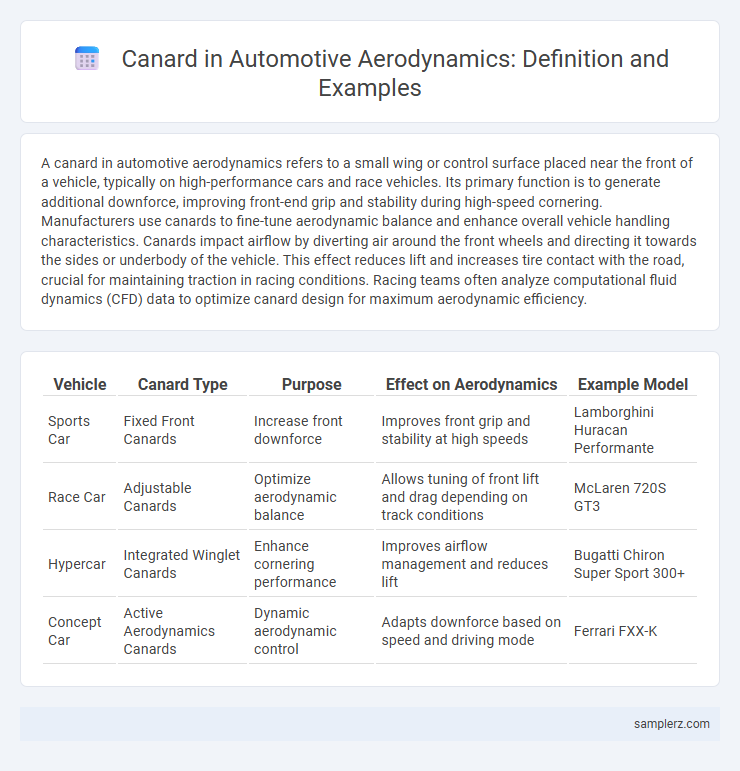A canard in automotive aerodynamics refers to a small wing or control surface placed near the front of a vehicle, typically on high-performance cars and race vehicles. Its primary function is to generate additional downforce, improving front-end grip and stability during high-speed cornering. Manufacturers use canards to fine-tune aerodynamic balance and enhance overall vehicle handling characteristics. Canards impact airflow by diverting air around the front wheels and directing it towards the sides or underbody of the vehicle. This effect reduces lift and increases tire contact with the road, crucial for maintaining traction in racing conditions. Racing teams often analyze computational fluid dynamics (CFD) data to optimize canard design for maximum aerodynamic efficiency.
Table of Comparison
| Vehicle | Canard Type | Purpose | Effect on Aerodynamics | Example Model |
|---|---|---|---|---|
| Sports Car | Fixed Front Canards | Increase front downforce | Improves front grip and stability at high speeds | Lamborghini Huracan Performante |
| Race Car | Adjustable Canards | Optimize aerodynamic balance | Allows tuning of front lift and drag depending on track conditions | McLaren 720S GT3 |
| Hypercar | Integrated Winglet Canards | Enhance cornering performance | Improves airflow management and reduces lift | Bugatti Chiron Super Sport 300+ |
| Concept Car | Active Aerodynamics Canards | Dynamic aerodynamic control | Adapts downforce based on speed and driving mode | Ferrari FXX-K |
Introduction to Canards in Automotive Aerodynamics
Canards in automotive aerodynamics are small, fin-like projections mounted near the front bumper to enhance front-end downforce and improve vehicle stability at high speeds. These aerodynamic devices manipulate airflow to increase grip and reduce understeer by directing air around the tires and chassis. Commonly used in performance and racing cars, canards contribute to optimized balance and cornering precision.
Historical Evolution of Canards in Car Design
Canards, small aerodynamic fins positioned near the front of vehicles, emerged in automotive design during the 1980s to enhance downforce and improve high-speed stability. Early applications appeared in racing vehicles like the Group C prototypes, where manufacturers integrated canards to manipulate airflow and increase cornering grip. Over time, advancements in computational fluid dynamics refined canard shapes, enabling manufacturers to optimize aerodynamic efficiency for both performance and fuel economy in modern supercars.
Functional Principles: How Canards Improve Downforce
Canards are small aerodynamic surfaces placed near the front of a vehicle, generating additional downforce by creating low-pressure zones above them and high-pressure zones beneath. This pressure differential enhances front-end grip and stability, improving cornering performance and overall handling. By directing airflow efficiently, canards also reduce lift and help balance aerodynamic forces across the chassis.
Common Materials Used for Automotive Canards
Automotive canards are commonly fabricated using lightweight materials such as carbon fiber, fiberglass, and ABS plastic to optimize aerodynamic efficiency and durability. Carbon fiber offers superior strength-to-weight ratio, making it ideal for high-performance applications, while fiberglass provides cost-effective flexibility and ease of repair. ABS plastic is favored for its impact resistance and ease of manufacturing, enabling mass production of aerodynamic components with precise design specifications.
Performance Impacts: Canards in Sports and Racing Cars
Canards on sports and racing cars significantly enhance aerodynamic performance by generating additional front downforce, improving high-speed stability and cornering grip. These small winglets optimize airflow around the vehicle, reducing lift and balancing aerodynamic load distribution for better handling. Effective canard design can lead to measurable lap time reductions through enhanced traction and vehicle responsiveness.
Notable Road Cars Featuring Factory Canards
Notable road cars featuring factory canards include the Ferrari 458 Speciale, which uses canards to increase front downforce and improve cornering stability. The McLaren 720S incorporates canards to optimize aerodynamic balance by directing airflow for enhanced high-speed grip. These factory-built canards demonstrate how performance-oriented manufacturers leverage aerodynamics to elevate handling and stability in road-legal vehicles.
Aftermarket Canard Designs for Enhanced Aerodynamics
Aftermarket canard designs in automotive aerodynamics focus on improving vehicle downforce and stability at high speeds by redirecting airflow along the car's body. These carbon fiber or ABS plastic canards are strategically installed near the front bumper to increase front-end grip and reduce aerodynamic drag. Popular among performance enthusiasts and track racers, aftermarket canards contribute to enhanced cornering precision and overall handling dynamics.
Comparative Analysis: Canards vs. Other Aero Devices
Canards in automotive aerodynamics provide improved front-end downforce compared to traditional front splitters, enhancing high-speed cornering stability. Unlike rear spoilers, canards generate localized lift reduction without significantly increasing drag, offering a more balanced aerodynamic profile. Their integration on race cars like the Porsche 911 GT3 RS demonstrates superior maneuverability and front grip over conventional diffusers and vortex generators.
Installation Considerations for Automotive Canards
Automotive canards require precise installation on the front bumper to optimize airflow and increase downforce without compromising vehicle balance. Positioning should ensure even distribution of aerodynamic pressure, typically near the lower corners, allowing effective vortex generation and improved cornering stability. Materials selected for mounting must withstand high speeds and vibrations, often necessitating reinforced brackets and aerodynamic fasteners to maintain durability and performance.
Future Trends: Advancements in Canard Technology
Emerging canard designs integrate adaptive materials and active control systems to optimize aerodynamic efficiency and vehicle stability at high speeds. Advanced computational fluid dynamics (CFD) simulations enable precision tuning of canard shapes for reduced drag and enhanced downforce across varying driving conditions. These innovations promise significant improvements in electric and autonomous vehicle performance by maximizing energy efficiency and handling precision.

example of canard in aerodynamics Infographic
 samplerz.com
samplerz.com